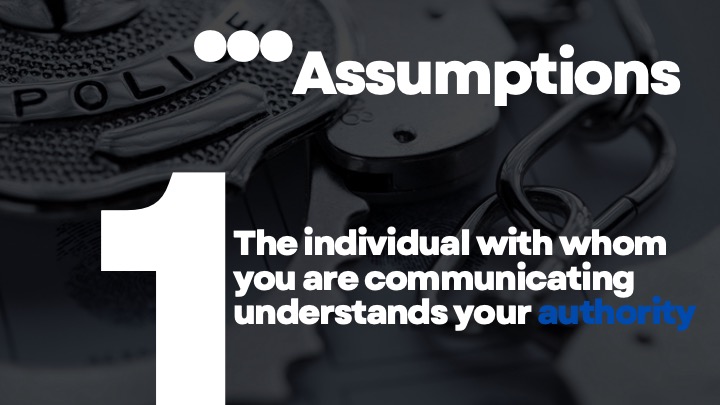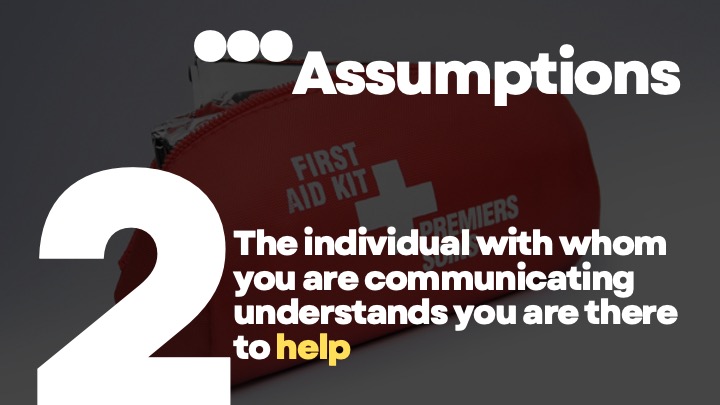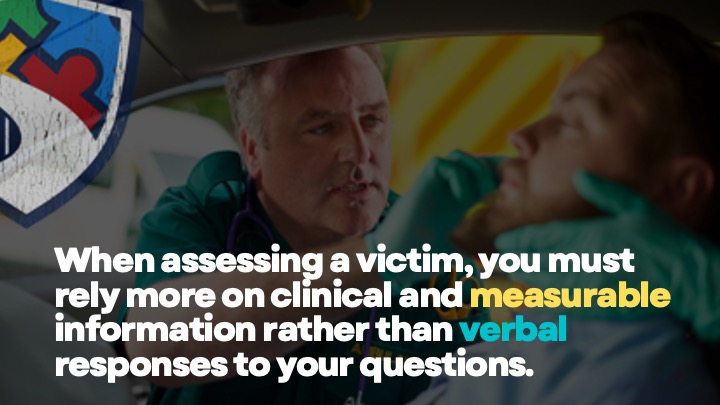
Autism and First Responders: The Top 3 Dangerous Assumptions We Make
Apr 28, 2022We take a lot for granted. As social creatures, we rely on hundreds of unwritten rules and expectations during our daily interactions with other people. Understandably, most of these unwritten rules become subconscious and burned into our lives as ASSUMPTIONS about how each social encounter will/should play out. As a result, we don't notice them until there is a discrepancy: someone acts outside expectations.
When I stop for gas (we can't pump our own gas in New Jersey), the attendant ASSUMES I will roll down my window and hand him my credit card. If I just sit and stare at him through the glass, the interaction will take an odd and comical turn.
As police officers and first responders, we carry many ASSUMPTIONS about our perceived status, role, and perception by society and the communities we serve. During an emergency, these ASSUMPTIONS provide value and efficiency to our interactions during calls for service.
Still, when interacting with individuals on the autism spectrum, we have to be careful with these assumptions as they often lead us to misunderstandings, miscommunication, and incorrect decisions.
Here are the Top 3 Dangerous Assumptions First Responders Make during our emergency responses or enforcement actions and how they may lead us to trouble when communicating with people on the autism spectrum:
"Authority"

We assume the person we are communicating with during an enforcement action understands and comprehends our authority. If you think about it, we rely heavily on this assumption. Our badges, uniforms, patrol cars, and rigs are all designed to convey a message: This person has authority, and society expects you to follow her instructions.
When I interview a suspected shoplifter while on duty and in uniform, implicit in the conversation are many assumptions:
- I have the authority to arrest you.
- I require information and have the authority to request it.
- Any furtive or aggressive action on your part will escalate our encounter.
- I have tools on my belt that can assist me in arresting you and causing you discomfort.
- If I can not arrest you by myself, I can use this magical communication device on my hip to call ten more of my associates to assist me in arresting you.
- The result of your arrest will bring social, financial, and legal ramifications.
All of these statements are baked into the encounter and usually unspoken. The suspect may despise law enforcement and have little respect for my authority, but he still understands its presence. Granted, sometimes people need a gentle reminder, but you get my point.
When communicating with someone you suspect to be on the autism spectrum, this implied understanding may not be there or challenged on some level. That badge on your chest may just be a shiny object that sparkles when the light hits it at a certain angle. That weapon on your hip may be the first time he has ever seen one of those cool toys from his favorite cartoon in real life. That patrol car may simply be another loud, smelly, scary monster that makes his ears hurt.
We must actively audit our assumptions about these interactions and consciously assess the effectiveness of our communication in real-time. And we must avoid perceiving responses that deviate from our expectations and assumptions as disrespectful, evasive, or evidence of guilt until we are sure something else (autism) is not at play.
"Good Guy"

During an emergency, we assume the victim we are treating understands and comprehends that we are there to HELP.
When I arrive at the scene of a car crash, implicit in that scene are many assumptions:
- This is an emergency.
- I am there to HELP you.
- I am not there to HURT you.
- I have skills, tools, training, and information to HELP you.
- To effectively HELP you, it is necessary for you to follow my instructions.
- Following my instructions is vital to your safety.
- I require information to assist me in HELPING you and are vital to your safety.
Again, especially when treating adult victims, these statements are assumed to be obvious and rarely overtly communicated.
However, none of this should be assumed when the victim is on the autism spectrum. I may be perceived as just another source of trauma and anxiety added to levels already through the roof due to the crash. My victim's fight-or-flight instinct may be so active that I am perceived as a THREAT. This vital information I am trying to provide and learn may have no value to my victim.
In these scenarios, a clear, calming, patient approach is critical. Limiting as much of the sensory noise (see my last article for more on this) is crucial. Your best options are to slow down our assessment and treatment (if there are no life-threatening injuries) and allow them time to de-escalate.
"Comprehension"
We assume the victim we are communicating with COMPREHENDS our questions and can provide reliable feedback.
"Do you have any numbness or tingling in your fingers or toes?" I have asked this question hundreds of times at the scene of car crashes. We know the answer is vital to our assessment to determine the possibility of a severe cervical injury.
My 18-year-old autistic son who looks like any other neurotypical young man does not know what "numbness or tingling means." Further, he doesn't want to speak to you and will say ANYTHING he believes will get you to stop asking questions. Additionally, he doesn't understand why it's in his own best interests to provide this information. His response CAN NOT be trusted as reliable.
Rather than verbal questions and answers, we have to rely more on visual and clinical measures during our assessments of individuals of suspected autistic individuals (deformities, swelling, bleeding, pulse, blood pressure, etc.).

"This makes sense, but how can I know if the individual is autistic?"
This can be challenging, but there are clues and ways to identify individuals on the autism spectrum. I offer a few insights here. Also, look around the scene for clues and indicators. These may include:
- Advocacy or awareness symbols and stickers
- Seemingly age-inappropriate toys (Sesame Street toys with no toddlers present)
- Assistive Communication Devices or apps on tablets or smartphones
- ID bracelets or tags
These calls for service are challenging to be sure. However, with patience and self-awareness of our assumptions, they are not insurmountable. As always, SAFETY (yours included) comes first. Please consider enrolling in my complete training course: Autism: A Guide for First Responders, for more insights.
Thank you for your service, and thank you for taking a few minutes to learn a little more about the special needs community. We need you desperately.




